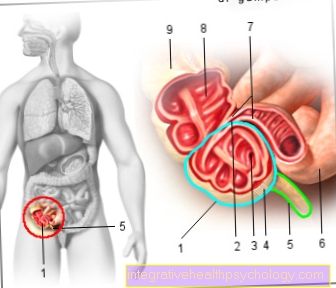Calcivit D
introduction
Calcivit® D is a vitamin-mineral combination preparation consisting of calcium carbonate 1500 mg (corresponds to 600 mg calcium) and vitamin D3 (Cholecalciferol) 400 I.U. to be taken twice a day.
If the preparation is used during pregnancy, however, it may only be taken once a day at the most. It is only available from a pharmacy, but does not require a prescription and is supplied in the form of effervescent or chewable tablets.
Read more on the topic: Vitamins in Pregnancy
The effervescent tablets are also available as Calcivit® D forte. Calcivit® D forte contains 2500 mg calcium carbonate (corresponds to 1000 mg calcium) and 880 I.U. Vitamin D3 (Cholecalciferol).

Areas of application
Calcivit® D is combined to compensate Calcium and vitamin D3 deficiencies or to Prophylaxis of such deficiencies used. This is particularly important with the Osteoporosis prophylaxis and Osteoporosis treatment a role.
Special features while ingestion:
While taking Calcivit® D, the Kidney function about the Determination of the creatinine value be checked in the serum. In addition, a repetitive Determination of the calcium level in serum and urine respectively. This is especially important in patients who are simultaneously Cardiac glycosides (digitoxin) and or Diuretics take and are of advanced age.
Enormous mindfulness is also involved in accompanying therapy Bisphosphonates, Sodium fluoride or Tetracyclines of necessity. If another preparation is taken that contains vitamin D3, the total dose delivered on vitamin D3 become. In patients who at Sarcoid (Boeck's disease) are ill, there is an increased change in vitamin D3 towards its active metabolites. Here too should the Calcium levels in the blood and urine be checked at regular intervals. Please inform your treating doctor if you have one Renal failure suffer as the Vitamin D3 metabolism is disturbed here is.
Side effects
Treatment with Calcivit® D can rarely lead to gastrointestinal complaints, how:
- diarrhea
- constipation
- Flatulence
- stomach pain and
- nausea
come. In the event of an overdose, symptoms similar to Vomiting and excessive thirst occur.
In rare cases:
- Rashes
- Itchy skin and
- Hives (Urticaria)
to be watched.
At long-term treatment and one co-existing renal insufficiency can a Hypercalcemia, i.e. an increase in the calcium concentration and / or hypercalciuria, i.e. an increased excretion of calcium in the urine.
Interactions
It may interact with diuretics (Diuretics of the thiazide type such as Hydrochlorothiazide) come, which eventually one Cause hypercalcemia can.
The effects of vitamin D3 can disturbed by the following drugs become:
- Barbiturates
- Glucocorticoids
- Phenytoin and
- Rifampicin
When taking Cholestyramine against a Hypercholesterolemia (too high Cholesterol levels in the blood) should at least two hours apart between taking Calcivit® D and colestyramine must be observed, otherwise the Recording of Calcivit® D impaired in the gastrointestinal tract can be.
Also the Absorption of iron may be disturbed by Calcivit® D, which is why preparations containing iron two hours before or two hours after ingestion of Calcivit® D should be added. This two hour interval also applies to that Cytostatic Estramustine.
With certain Antibiotics, like for example Tetracyclines or Bisphosphonates and Sodium fluoride should be the distance at least three hours be. Since taking Calcivit® D leads to a Increase in calcium levels may occur in the blood, there is a possibility that the sensitivity to drugs that are used in one Heart failure be used (Cardiac glycosides) is increased and the risk for Cardiac arrhythmias is increased.
Interactions with food are also known. Come into question Food with:
- Oxalic acid (like for example rhubarb, Star fruits, Swiss chard, cocoa and many more)
- Phytic acid (for example in corn, soy or peanut)
- Phosphates (e.g. in processed cheese or soft drinks) or
- Food with a significant amount of fiber
pregnancy and breast feeding period
Calcivit® D can be used during pregnancy and breastfeeding to correct a calcium and vitamin D3 (cholecalciferol) deficiency. However, it is important that a maximum of 1 tablet is taken per day so that a daily dose of 1500 mg calcium and 600 I.U. is not exceeded.
When breastfeeding, it should be noted that calcium and vitamin D3 (cholecalciferol) pass into breast milk. Calcivit® D should be taken by pregnant and breastfeeding women two hours before or after a meal, as otherwise iron absorption in the gastrointestinal tract may be impeded.
Contraindications
Calcivit® D must not be part of the therapy plan if patients are too Hypersensitivity reactions across from
- Calcium carbonate
- Vitamin D3 (Cholecalciferol) or
- other components of this vitamin and mineral preparation (e.g. soy)
tend. In addition, it must not be with a increased calcium levels in the blood (Hypercalcemia), one increased urinary calcium excretion (Hypercalcuria) or long-term immobilization with hypercalcemia and / or hypercalcuria.
Further contraindications for therapy with Calcivit® D are:
- Kidney stones
- Myeloma (Cancer of the bone marrow)
- Bone metastases and
- primary hyperparathyroidism (pHPT), i.e. an overactive parathyroid gland
Caution is advised with the following ailments:
- decreased kidney function
- Kidney calcification
- lesser Phosphate concentration in blood (Hypophosphatemia)
If you are unsure, you should definitely consult your doctor or pharmacist.
























.jpg)



